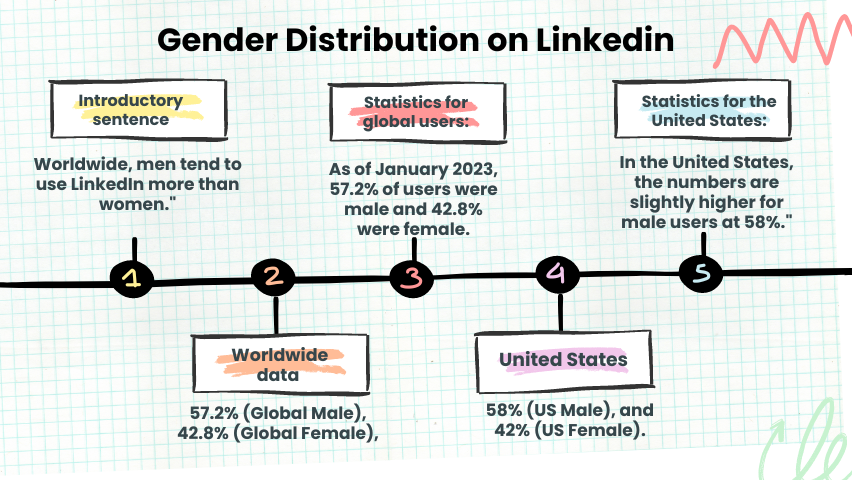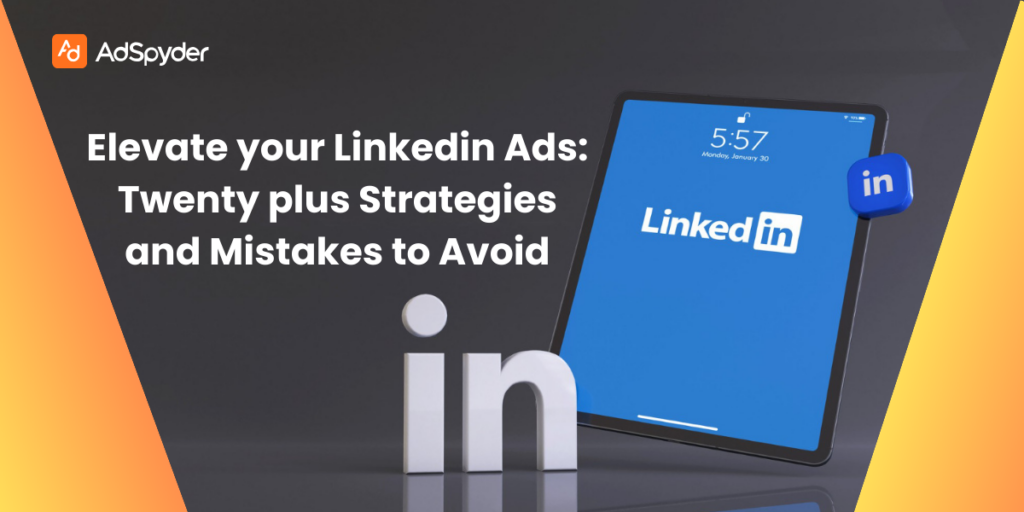LinkedIn stands out as a platform for running ad campaigns. However, like any other social networking platform, Linkedin campaign management requires the use of a strategic approach to ensure the delivery of the results. In this guide, we have rounded up 20-plus insider Linkedin ad strategies to help you navigate the obstacle and get the desired results. Let’s dive right into it.
Ready to Elevate your Marketing Strategy?
Understanding LinkedIn’s Unique Environment

LinkedIn is not your ordinary social media ads platform; rather it is a platform where individuals and professionals from different industries come together to share their experiences, and industry insight and seek opportunities. Some professionals post job ads on Linkedin to hire the perfect candidate for the filing. Thus, for brands considering running an ad on Linkedin, it becomes crucial for them to understand the mindset of LinkedIn users. With that said, Linkedin brings together professional people who are actively seeking information related to their industry. Not only this, they are always up for information that can help them develop professionally.
For that reason, Brands must tailor their ads considering the professional element involved in this platform. While tailoring ads, the brands must craft messages that directly convey the information to the target audience. Additionally, the use of industry-specific language and showcasing the value of a product becomes paramount.
The LinkedIn Audience: Characteristics and Behaviors
The LinkedIn audience is characterized by a diverse group of professionals across various industries, united by a shared commitment to career development and industry insights. With a distinct professional mindset, users actively seek valuable content and networking opportunities. LinkedIn serves as a hub for discussions, career advancement, and the sharing of industry-specific insights. Users showcase their professional identities through detailed profiles, emphasizing credibility.
LinkedIn’s Ad Formats and Their Best Uses
No matter whether it is linkedin b2b ads or b2c ads, brands must know that the platforms support different formats of ads. While running a LinkedIn ad campaign, it is best to get yourself familiar with the strength and the best use of each ad, allowing you to modify your content according to the objectives you want to achieve through the LinkedIn ad campaign. Let’s check out different types of LinkedIn ad formats and how you can use them:
- Linkedin Sponsored Content – Ideal for promoting content directly in the LinkedIn feed.
- Sponsored InMail: Effective for personalized messages delivered directly to users’ inboxes. These are also called linked-in conversation ads since they appear in the conversation tab.
- Display Ads: Suited for increasing brand awareness and reaching a broad audience, and Monitor your competitors’ display ads
- LinkedIn Video Ads: Perfect for engaging storytelling and visual content.
- Carousel Ads on LinkedIn: Great for displaying multiple images or videos in a single ad.
- LinkedIn Dynamic Ads: Tailored for personalized content based on users’ LinkedIn profiles.
Setting Up Your Campaign for Success
Crafting a winning Linkedin advertising campaign involves careful preparation and implementation. In truth, these two items provide a reliable basis for ensuring that an ad campaign works. Campaign objectives should be clearly specified by the brands. Whether the goal is brand awareness, lead generation form on LinkedIn, or increased website traffic–knowing what you want to achieve with this ad campaign will help develop an appropriate strategy.
One important issue that you need to factor in while creating the campaign is the budget. After deciding on your goals, the next step is to establish a budget for the same. Consider the types of ad formats you need to communicate your message effectively, using sponsored content or sponsored InMail and display ads.
Defining Clear Objectives
Defining clear objectives is the key to successful LinkedIn Ad campaigns. You should have information about what your objectives are. For instance, your objective might be to increase website traffic or you may want to generate more leads. By clearly defining the goals, the advertisers can create strategies, and analyze data and performance metrics to get the desired output. Knowing clear objectives can be helpful in the allocation of resources, and setting the right budget.
Target Audience Selection: Best Practices

The targeting of the audience is a crucial element for effective LinkedIn ads and some vital tips must be considered. To begin with, advertisers can develop distinct buyer personas describing their ideal customers. This assists in the determination of whom to reach. LinkedIn provides a whole array of targeting options, such as job titles and industries. They review and adjust their audience from time to time based on the performance of ads. Additionally, the use of A/B testing to test out various audience segments can help find what works best.
Budgeting and Bidding Strategies
The most essential part of LinkedIn advertising is the development of effective budgeting and bidding strategies that guarantee a high level of return on investment. The initial step involves setting up a defined budget. Using CPC or the cost per impression (CPM) options available on LinkedIn, advertisers can tailor their strategy for different objectives of campaigns. While doing so, It is important to monitor and modify the bidding strategy to performance measures. With increase in ad costs, it is more imprtant to correctly maange your bidding process.
Crafting Compelling Ad Content
Linkedin is a platform where professionalism is the key. Thus, to stand out from the crowd, the brands must be able to craft high-quality and attention-grabbing content copy. Doing this ensures that the message you want to convey reaches the right audience while maintaining a professional tone.
It would be wrong to say that only compelling Ad content can get the results you are looking for. Incorporating ads with visual elements will complement the ad copy and garner more attention in digital advertising from your target audience. Ask yourself where your inclination would be – towards content featuring text only or towards content that has a combination of text and visual elements. Surely, the latter one.
Further, add a clear Call-to-action (CTA) to prompt your audience to take the desired action that you want them to take.
Designing Visually Appealing Ad Creatives
As mentioned above, text alone is not enough for advertisers to get the desired output. Incorporating visual elements in the ad copy can easily draw the attention of the audience. While designing appealing ad creatives, there are a few considerations that you need to keep in mind:
- Maintain a consistent theme in each of your creatives. This will help in spreading brand awareness.
- Use compelling headlines, concise copy, and high-impact visuals to convey your value proposition swiftly.
- Make sure to use high-quality visual elements in your ad creation to make it attention-grabbing for viewers.
Writing Engaging and Relevant Ad Copy
To capture the attention of the audience, the advertisers must make efforts to stand out. One way to do so is by investing time, and effort in writing engaging and relevant copy. Before writing an ad copy, it is recommended to understand the pain points of your target audience, along with their aspirations and interests. The headline you create is the first thing that the audience will come across, make sure it is worth their watch. Some of the other practices include:
- Communicate how your offering solves a problem or fulfills a need for your audience.
- Encourage prompt action by incorporating a sense of urgency in your ad copy.
Utilizing Video Content Effectively
Effectively utilizing video content on LinkedIn involves capturing attention with a compelling hook, keeping videos short and impactful, and telling engaging stories that showcase your brand personality. Optimize for silent viewing, leverage LinkedIn’s native video features, and encourage audience engagement. Educational content and how-to videos can position your brand as an industry authority while optimizing for mobile ensures accessibility. Track performance through analytics, refining your strategy based on insights. With concise, valuable, and visually appealing linkedin video ads, you can boost brand visibility, engagement, and connection with your LinkedIn audience.
Advanced Targeting Techniques
LinkedIn’s advanced targeting options enable you to hone in on your ideal audience. Explore account-based marketing (ABM) strategies, tailoring your ads to specific companies or industries. Utilize job function targeting to reach professionals with specific roles crucial to your business.
Experiment with linkedin retargeting campaigns to engage users who have previously interacted with your brand. This precision targeting ensures that your ads reach the individuals most likely to convert, maximizing the efficiency of your advertising spend.
Leveraging LinkedIn’s Demographic Data
Using demographic data from LinkedIn is a tactical move that can help to narrow targeting to show the correct audience with your content. Given the abundance of professional information, brands can focus on critical demographics like job positions, industries, company size, and locations to identify your target audience. This data-driven technique enables targeted audience segmentation, ensuring that the content aligns in tune with the professional interests and needs of LinkedIn users.
Interest and Skill-Based Targeting
Interest and skill-based targeting is the strategy for a successful LinkedIn Ad campaign. The advertisers can build an audience who have expressed specific interest. To put it in simpler words, professionals who have shown interest in Business and Management can be targeted considering that the advertisers have selected those interests to target their audience. It does not necessarily mean that the audience works in this industry. Craft your ad content to directly address these interests, showcasing how your product or service aligns with their professional pursuits.
Account and Contact Targeting
Account and contact targeting on LinkedIn is an effective approach to reaching potential companies or customers that relate to your business. The major benefit of using this strategy is that it lets you build a custom audience depending on the demographics. Additionally, account and contact targeting will help deliver the relevant ad content, allowing you to retain your clients and win back customers. Using LinkedIn’s advanced targeting features, your campaigns can be concentrated on important accounts and key decision-makers within such organizations.
Optimization and Testing Linkedin Ad Strategies

Using different approaches and refining them frequently is the key to continuous success with LinkedIn advertising. One of the best Linkedin ad strategies is to experiment with A/B testing taking different ad variations. Not only ad variation but make sure to experiment with different headlines and even images. Once you have tested with these different variations, now is the time to analyze performance metrics to identify what resonates best with your audience.
Furthermore, it is a good idea to keep adjusting your bid strategy depending on the performance of the data. There are various options to choose from i.e. cost per click (CPC) or cost per impression (CPM). You can choose either of them depending on what the objective of your campaigns is. To enhance overall campaign performance, make sure to review these metrics regularly.
A/B Testing for Ads and Landing Pages
A/B Testing for Ads and Landing pages holds significant importance in achieving desired goals. It means experimenting with your ad with different variations to find out what works best for your audience. By incorporating variations in ad elements and landing pages, the advertisers can analyze the performance metrics to get an idea of which variation garnered more attention from the audience. Through continuous iteration and optimization based on conclusive results, businesses can fine-tune their messaging, ultimately maximizing the efficiency and impact of their LinkedIn advertising management.
Analyzing and Interpreting Campaign Data
After the brands have created ads and they are live on a LinkedIn account, the next step that comes in the way is to take advantage of Campaign Manager which can generate useful and insightful reports. These reports contain analytical details about the performance of the ad campaign in response to the predefined metrics that have been set up during the process of ad creation. By analyzing this information, the advertisers can figure out the areas where there is a need for refinement to increase overall performance. With this information, the marketers can make necessary modifications, thereby, improving the ad performance and ultimately, getting a higher return on investment.
Continuous Optimization: When and How to Adjust Campaigns
Adapting and re-iterating changes in the ad campaign is crucial and knowing when and how to do them plays a significant role in boosting the performance of LinkedIn Ads. Here are some tips that will help you out on this front:
- Conduct a comprehensive review of ad performance periodically.
- Analyze the results of A/B Testing to figure out what changes worked best for your audience. Use this data to inform adjustments to your ad creatives, headlines, or targeting Linkedin ad strategies.
- Keep an eye on your competitor and create Linkedin ad strategies based on that. Considering that there is a shift in the behavior of the audience, make sure to incorporate the changes accordingly.
Leveraging LinkedIn’s Tools and Features
Using the variety of tools and features that LinkedIn can offer is essential for having an effective Linkedin ad strategies. These tools deliver a range of functionalities that allow advertisers to personalize their campaigns with great accuracy and deftness. Each of the tools from Lead Gen Forms to Sponsored InMail helps streamline lead generation, personalized messages directly in user’s inboxes serve as another tool for better engaging users.
Video Ads help to create visually engaging narratives, whereas Dynamic Ads come with a personalized touch because they change the content based on LinkedIn profiles. LinkedIn’s Campaign Manager delivers comprehensive analytics that not only helps to have a real-time performance report but also guides with strategic decisions going forward towards optimization. More specifically, if marketers apply these tools properly in their advertising efforts so that by adopting them they can earn more reach and engage with target audiences using linkedin targeted ads on the LinkedIn network.
Utilizing LinkedIn Insight Tag
LinkedIn Insight Tag is a powerful feature that allows brands to dive deeper into campaign reporting and website retargeting. The Insight tag provides plenty of information related to your audience. For instance, the brands can find out the demographics of the website visitors, including their job titles, companies, industries, and more. Additionally, LinkedIn Insight Tag is also helpful in re-targeting and engaging audiences who have come to your website but have not taken any sort of action. The highlight of the Insight tag is that it is free to be used.
Exploring LinkedIn’s Matched Audience
Exploring LinkedIn’s Matched Audience feature allows advertisers to strategically target specific audiences based on their existing data. By uploading lists of contacts, website retargeting, or engaging with video content, businesses can precisely reach and reconnect with their intended audience on LinkedIn. This feature facilitates personalized messaging and enhances the relevance of ad campaigns, ultimately maximizing engagement and driving desired actions from a carefully curated audience.
Linkedin Ad Strategies: Best Practices for Scaling Your Campaigns
Scaling your LinkedIn advertising campaigns requires a strategic approach. Begin by expanding your targeting options, and exploring additional industries or job titles within your audience. Diversify your ad formats to keep your campaigns fresh and appealing to a broader audience.
As you scale, maintain a keen focus on efficiency. Monitor the performance of your campaigns closely, identifying what works best as you broaden your reach. Fine-tune your Linkedin ad strategies based on the evolving needs and responses of your expanding audience, ensuring sustained success as you grow your advertising efforts on LinkedIn.
When and How to Scale Your Ad Spend
Scaling your ad spend is a strategic decision that can set the tone for a successful LinkedIn ad campaign. Here’s what you need to know about when and how to scale your Ad spend:
- Regularly monitor key metrics such as CTR, conversion rates, and other metrics. Once you feel that you are achieving performance goals, you can gradually increase ad spend.
- When scaling your ad spend, consider the size of your targeted audience. Make sure that your targeted audience is large.
- Consider scaling when A/B tests indicate successful variations that can be applied across a larger budget.
Expanding Your Audience While Maintaining Relevance
Expand your campaign’s reach with Audience Expansion by showing ads to audiences similar to your target audience. For example, if you target those with the skill “Online Advertising,” it may include those with “Interactive Marketing” skills. This helps discover new prospects automatically. Remember, excluding certain attributes won’t be part of Audience Expansion, allowing you to customize your audience further.
Diversifying Ad Formats for Broader Reach
To maximize the result of a LinkedIn ad campaign, using different ad formats can help brands reach a wider audience. Different audiences consume different formats and by incorporating different ad formats, the brands will cater to different portions of the audience. The additional benefit of using different ad formats is that each of these variations comes with its added benefit. For instance, if you wish to highlight the benefits of your products or services, using the linkedin carousel ad format will be an ideal ad format, keeping the audience hooked and engaged.
Linkedin Ad Strategies: Avoiding Common Pitfalls
Ignoring Ad relevance, and not noting the performance analytics are a few of the common pitfalls that can break your Linkedin ad campaign and not get you the results that you are looking for. On the other hand, precise audience targeting, reiterating the ad for optimization, and using performance metrics to review your ads can go a long way in driving success for your LinkedIn ad campaign. Regular analysis, A/B testing, and adherence to best practices ensure sustained performance and contribute to a positive return on investment.
Common LinkedIn Ad Mistakes and How to Avoid Them
Some of the common LinkedIn Ad mistakes are rounded up below. Take a look at them and make sure to avoid such mistakes.
- Neglecting Audience Targeting: Avoid broad targeting. Define a specific audience to ensure your ads reach those most likely to engage with your content.
- Ignoring Ad Relevance: Craft compelling and relevant ad content. Irrelevant or generic messaging can lead to low engagement.
- Forgetting Mobile Optimization: Optimize ads for mobile users. Neglecting mobile can limit your campaign’s reach and effectiveness.
Compliance and Best Practices for LinkedIn Ads
The brands must ensure best practices and compliance when running ads on Linkedin. If your niche is regulated, such as online betting sites, it is important to follow rules for online gambling advertising. Here’s what they need to know:
- Adherence to LinkedIn Policies
- Avoid Discrimination
- Clear Call-to-Action (CTA)
- Regular Monitoring
Conclusion
Creating and driving results from LinkedIn Ad campaigns revolves around having information about the dynamic nature of LinkedIn’s platform, meticulously creating compelling content along setting accounts for campaigns. However, many other key ingredients can help brands reach their objectives of running a LinkedIn ad campaign. This guide would have informed you about the Linkedin ad strategies that could help brands reach a wider audience and ultimately increase conversion.




